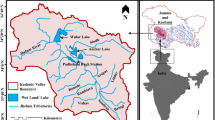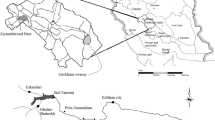Abstract
Horizontal displacement of hydropower dams is a typical nonlinear time-varying behavior that is difficult to forecast with high accuracy. This paper proposes a novel hybrid artificial intelligent approach, namely swarm optimized neural fuzzy inference system (SONFIS), for modeling and forecasting of the horizontal displacement of hydropower dams. In the proposed model, neural fuzzy inference system is used to create a regression model whereas Particle swarm optimization is employed to search the best parameters for the model. In this work, time series monitoring data (horizontal displacement, air temperature, upstream reservoir water level, and dam aging) measured for 11 years (1999–2010) of the Hoa Binh hydropower dam were selected as a case study. The data were then split into a ratio of 70:30 for developing and validating the hybrid model. The performance of the resulting model was assessed using RMSE, MAE, and R 2. Experimental results show that the proposed SONFIS model performed well on both the training and validation datasets. The results were then compared with those derived from current state-of-the-art benchmark methods using the same data, such as support vector regression, multilayer perceptron neural networks, Gaussian processes, and Random forests. In addition, results from a Different evolution-based neural fuzzy model are included. Since the performance of the SONFIS model outperforms these benchmark models with the monitoring data at hand, the proposed model, therefore, is a promising tool for modeling horizontal displacement of hydropower dams.







Similar content being viewed by others
References
Salazar F, Morán R, Toledo M, Oñate E (2015) Data-based models for the prediction of dam behaviour: a review and some methodological considerations. Arch Comput Methods Eng. doi:10.1007/s11831-015-9157-9
Salazar F, Toledo MA, Oñate E, Morán R (2015) An empirical comparison of machine learning techniques for dam behaviour modelling. Struct Saf 56:9–17. doi:10.1016/j.strusafe.2015.05.001
De Sortis A, Paoliani P (2007) Statistical analysis and structural identification in concrete dam monitoring. Eng Struct 29(1):110–120
Mata J (2011) Interpretation of concrete dam behaviour with artificial neural network and multiple linear regression models. Eng Struct 33(3):903–910. doi:10.1016/j.engstruct.2010.12.011
Bayrak T (2007) Modelling the relationship between water level and vertical displacements on the Yamula Dam, Turkey. Nat Hazards Earth Syst Sci 7(2):289–297
Areias P, Belytschko T (2005) Analysis of three-dimensional crack initiation and propagation using the extended finite element method. Int J Numer Meth Eng 63(5):760–788
Antes H, Von Estorff O (1987) Analysis of absorption effects on the dynamic response of dam reservoir systems by boundary element methods. Earthq Eng Struct Dyn 15(8):1023–1036
Vanatwerp R (1994) Engineering and design: deformation monitoring and control surveying. Engineer manual—US Army corps of engineering EM:1110-1111
Stojanovic B, Milivojevic M, Ivanovic M, Milivojevic N, Divac D (2013) Adaptive system for dam behavior modeling based on linear regression and genetic algorithms. Adv Eng Softw 65:182–190. doi:10.1016/j.advengsoft.2013.06.019
Xu C, Yue D, Deng C (2012) Hybrid GA/SIMPLS as alternative regression model in dam deformation analysis. Eng Appl Artif Intell 25(3):468–475. doi:10.1016/j.engappai.2011.09.020
Seyedpoor S, Salajegheh J, Salajegheh E, Gholizadeh S (2009) Optimum shape design of arch dams for earthquake loading using a fuzzy inference system and wavelet neural networks. Eng Optim 41(5):473–493
Karimi I, Khaji N, Ahmadi M, Mirzayee M (2010) System identification of concrete gravity dams using artificial neural networks based on a hybrid finite element–boundary element approach. Eng Struct 32(11):3583–3591
Ranković V, Grujović N, Divac D, Milivojević N, Novaković A (2012) Modelling of dam behaviour based on neuro-fuzzy identification. Eng Struct 35:107–113
Kao CY, Loh CH (2013) Monitoring of long-term static deformation data of Fei-Tsui arch dam using artificial neural network-based approaches. Struct Control Health Monit 20(3):282–303
Zheng D, Cheng L, Bao T, Lv B (2013) Integrated parameter inversion analysis method of a CFRD based on multi-output support vector machines and the clonal selection algorithm. Comput Geotech 47:68–77. doi:10.1016/j.compgeo.2012.07.006
Ranković V, Grujović N, Divac D, Milivojević N (2014) Development of support vector regression identification model for prediction of dam structural behaviour. Struct Saf 48:33–39
Su H, Wen Z, Sun X, Li H (2015) Rough set-support vector machine-based real-time monitoring model of safety status during dangerous dam reinforcement. Int J Damage Mech. doi:10.1177/1056789515616448
Salazar F, Toledo MÁ, Oñate E, Suárez B (2016) Interpretation of dam deformation and leakage with boosted regression trees. Eng Struct 119:230–251. doi:10.1016/j.engstruct.2016.04.012
Tien Bui D, Nguyen Q-P, Hoang N-D, Klempe H (2016) A novel fuzzy K-nearest neighbor inference model with differential evolution for spatial prediction of rainfall-induced shallow landslides in a tropical hilly area using GIS. Landslides. doi:10.1007/s10346-016-0708-4
Hoang N-D, Tien Bui D (2016) A novel relevance vector machine classifier with cuckoo search optimization for spatial prediction of landslides. J Comput Civ Eng. doi:10.1061/(ASCE)CP.1943-5487.0000557
Hoang N-D, Tien Bui D, Liao K-W (2016) Groutability estimation of grouting processes with cement grouts using differential flower pollination optimized support vector machine. Appl Soft Comput 45:173–186. doi:10.1016/j.asoc.2016.04.031
Price K, Storn RM, Lampinen JA (2006) Differential evolution: a practical approach to global optimization. Springer, New York
Tien Bui D, Pham TB, Nguyen Q-P, Hoang N-D (2016) Spatial Prediction of rainfall-induced shallow landslides using hybrid integration approach of least squares support vector machines and differential evolution optimization: a case study in Central Vietnam. Int J Digit Earth. doi:10.1080/1753894720161169561
Goldberg DE, Holland JH (1988) Genetic algorithms and machine learning. Mach Learn 3(2):95–99
Tien Bui D, Pradhan B, Nampak H, Quang Bui T, Tran Q-A, Nguyen QP (2016) Hybrid artificial intelligence approach based on neural fuzzy inference model and metaheuristic optimization for flood susceptibility modelling in a high-frequency tropical cyclone area using GIS. J Hydrol 540:317–330. doi:10.1016/j.jhydrol.2016.06.027
Ingber L (1993) Simulated annealing: practice versus theory. Math Comput Model 18(11):29–57
Parpinelli RS, Lopes HS, Freitas A (2002) Data mining with an ant colony optimization algorithm. Evol Comput IEEE Trans 6(4):321–332
Tien Bui D, Anh Tuan T, Hoang N-D, Quoc Thanh N, Nguyen BD, Van Liem N, Pradhan B (2016) Spatial prediction of rainfall-induced landslides for the Lao Cai area (Vietnam) using a novel hybrid intelligent approach of least squares support vector machines inference model and artificial bee colony optimization. Landslides. doi:10.1007/s10346-016-0711-9
Karaboga D, Gorkemli B, Ozturk C, Karaboga N (2014) A comprehensive survey: artificial bee colony (ABC) algorithm and applications. Artif Intell Rev 42(1):21–57
Kennedy J, Eberhart R (1995) Proceedings of IEEE international conference on neural networks. Perth, Australia
Song S, Kong L, Gan Y, Su R (2008) Hybrid particle swarm cooperative optimization algorithm and its application to MBC in alumina production. Prog Nat Sci 18(11):1423–1428. doi:10.1016/j.pnsc.2008.04.008
Voglis C, Parsopoulos KE, Papageorgiou DG, Lagaris IE, Vrahatis MN (2012) Mempsode: A global optimization software based on hybridization of population-based algorithms and local searches. Comput Phys Commun 183(5):1139–1154
Jang JSR (1993) ANFIS: Adaptive-network-based fuzzy inference system. IEEE Trans Syst Man Cybern 23(3):665–685
Tien Bui D, Bui Q-T, Nguyen Q-P, Pradhan B, Nampak H, Trinh PT (2016) A hybrid artificial intelligence approach using GIS-based neural-fuzzy inference system and particle swarm optimization for forest fire susceptibility modeling at a tropical area. doi:10.1016/j.agrformet.2016.11.002
Vladimirov VB, Zaretskii YK, Orekhov VB (2003) A mathematical model for monitoring the rock-earthen dam of the Hoa Binh hydraulic power system. Power Technol Eng 37(3):161–166. doi:10.1023/A:1025682101823
Nguyen TT, Pham VD, Tenhunen J (2013) Linking regional land use and payments for forest hydrological services: a case study of Hoa Binh Reservoir in Vietnam. Land Use Policy 33:130–140. doi:10.1016/j.landusepol.2012.12.015
Oro S, Mafioleti T, Chaves Neto A, Garcia S, Neumann Júnior C (2016) Study of the influence of temperature and water level of the reservoir about the displacement of a concrete dam. Int J Appl Mech Eng 21(1):107–120
Tien Bui D, Pradhan B, Lofman O, Revhaug I, Dick O (2013) Regional prediction of landslide hazard using probability analysis of intense rainfall in the Hoa Binh province, Vietnam. Nat Hazards 66(2):707–730
Tien Bui D, Pradhan B, Lofman O, Revhaug I, Dick OB (2012) Landslide susceptibility mapping at Hoa Binh province (Vietnam) using an adaptive neuro-fuzzy inference system and GIS. Comput Geosci 45:199–211. doi:10.1016/j.cageo.2011.10.031
Abdulshahed AM, Longstaff AP, Fletcher S (2015) The application of ANFIS prediction models for thermal error compensation on CNC machine tools. Appl Soft Comput 27:158–168. doi:10.1016/j.asoc.2014.11.012
Poli R, Kennedy J, Blackwell T (2007) Particle swarm optimization. Swarm Intell 1(1):33–57
Chai T, Draxler RR (2014) Root mean square error (RMSE) or mean absolute error (MAE)? Arguments against avoiding RMSE in the literature. Geosci Model Dev 7(3):1247–1250
Were K, Tien Bui D, Dick ØB, Singh BR (2015) A comparative assessment of support vector regression, artificial neural networks, and random forests for predicting and mapping soil organic carbon stocks across an Afromontane landscape. Ecol Indic 52:394–403
Tien Bui D, Pradhan B, Lofman O, Revhaug I (2012) Landslide susceptibility assessment in Vietnam using Support vector machines, Decision tree and Naïve Bayes models. Math Probl Eng 2012:1–26
Tien Bui D, Pradhan B, Lofman O, Revhaug I, Dick OB (2012) Application of support vector machines in landslide susceptibility assessment for the Hoa Binh province (Vietnam) with kernel functions analysis. In: Seppelt R, Voinov AA, Lange S, Bankamp D (eds) Proceedings of the iEMSs sixth biennial meeting: international congress on environmental modelling and software (iEMSs 2012). International Environmental Modelling and Software Society, Leipzig
Hong H, Pradhan B, Xu C, Tien Bui D (2015) Spatial prediction of landslide hazard at the Yihuang area (China) using two-class kernel logistic regression, alternating decision tree and support vector machines. CATENA 133:266–281. doi:10.1016/j.catena.2015.05.019
Tien Bui D, Tuan TA, Klempe H, Pradhan B, Revhaug I (2016) Spatial prediction models for shallow landslide hazards: a comparative assessment of the efficacy of support vector machines, artificial neural networks, kernel logistic regression, and logistic model tree. Landslides 13:361–378. doi:10.1007/s10346-015-0557-6
Beck PS, Goetz SJ, Mack MC, Alexander HD, Jin Y, Randerson JT, Loranty M (2011) The impacts and implications of an intensifying fire regime on Alaskan boreal forest composition and albedo. Glob Change Biol 17(9):2853–2866
Verrelst J, Muñoz J, Alonso L, Delegido J, Rivera JP, Camps-Valls G, Moreno J (2012) Machine learning regression algorithms for biophysical parameter retrieval: Opportunities for Sentinel-2 and -3. Remote Sens Environ 118:127–139. doi:10.1016/j.rse.2011.11.002
Grbić R, Kurtagić D, Slišković D (2013) Stream water temperature prediction based on Gaussian process regression. Expert Syst Appl 40(18):7407–7414
Ranković V, Novaković A, Grujović N, Divac D, Milivojević N (2014) Predicting piezometric water level in dams via artificial neural networks. Neural Comput Appl 24(5):1115–1121
Francke T, López-Tarazón J, Schröder B (2008) Estimation of suspended sediment concentration and yield using linear models, random forests and quantile regression forests. Hydrol Process 22(25):4892–4904
Shah AD, Bartlett JW, Carpenter J, Nicholas O, Hemingway H (2014) Comparison of random forest and parametric imputation models for imputing missing data using MICE: a CALIBER study. Am J Epidemiol 179(6):764–774
Chouinard L, Roy V (2006) Performance of statistical models for dam monitoring data. Paper presented at the joint international conference on computing and decision making in civil and building engineering, Montreal
Swiss Committee on Dams (2003) Methods of analysis for the prediction and the verification of dam behaviour. Tech. rep, ICOLD
International Commission on Large Dams (2012) Dam surveillance guide. Tech. Rep. B-158, ICOLD
Acknowledgements
This research was funded by the China Scholarship Council (CSC) and partially supported by the Project 322 (Vietnam). The data analysis and write-up were carried out as a part of the first author’s Ph.D. studies at the School of Geodesy and Geomatics, Wuhan University, P. R. of China. We would like to thank two anonymous reviewers for their constructive and valuable comments on the earlier version of the manuscript.
Author information
Authors and Affiliations
Corresponding author
Ethics declarations
Conflict of interest
The authors declare no conflict of interest.
Rights and permissions
About this article
Cite this article
Bui, KT.T., Tien Bui, D., Zou, J. et al. A novel hybrid artificial intelligent approach based on neural fuzzy inference model and particle swarm optimization for horizontal displacement modeling of hydropower dam. Neural Comput & Applic 29, 1495–1506 (2018). https://doi.org/10.1007/s00521-016-2666-0
Received:
Accepted:
Published:
Issue Date:
DOI: https://doi.org/10.1007/s00521-016-2666-0




